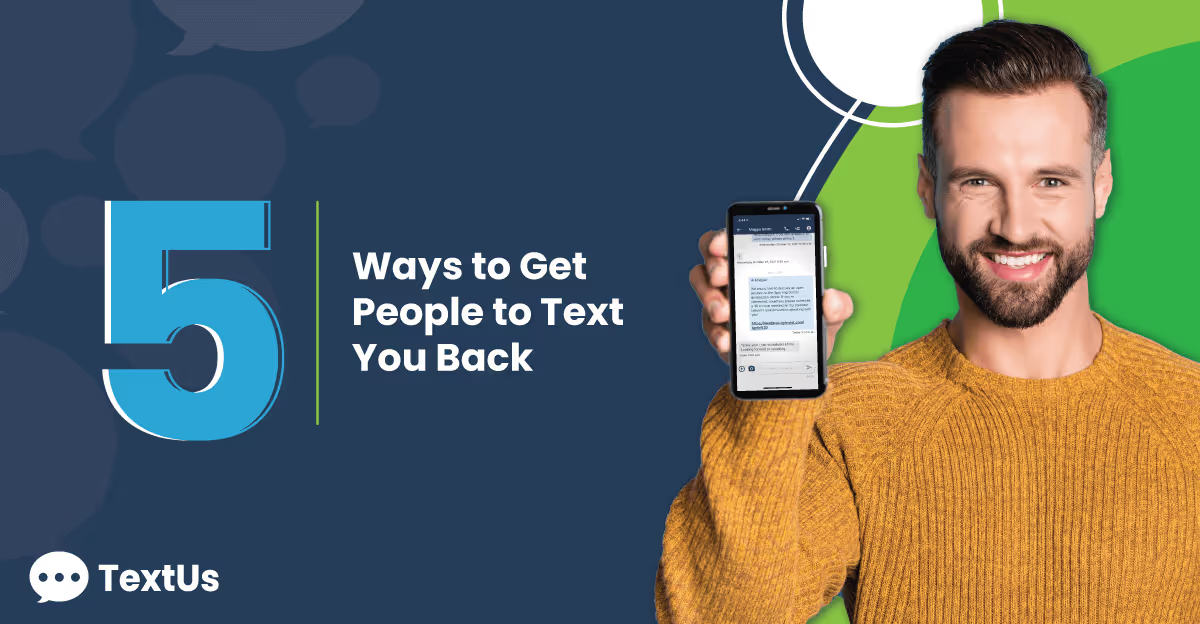5 Ways to Get People to Text You Back
Stop texting into the void. This post shows you exactly how to get faster, more frequent replies to every business text.
Published
September 2, 2022

With a 98% average read rate and roughly 35% response rate, SMS outperforms email and phone calls across every industry (Emarsys, 2024; OptiMonk, 2024). In today’s fast-moving world, every text message sent is a real-time chance to start a conversation, convert a lead, or re-engage a candidate. Businesses that don’t optimize their texting strategy risk falling behind.
How to Improve SMS Response Rates
With impressive results compared to email, how can you make sure that you increase your response rate? Here are five ways we have seen our customers get people to respond.
Personalize every text
Personalized texts yield up to 4× higher reply rates. One-to-one messages show your audience . When recipients see their name, relevant context, or a reference to their needs, they’re more likely to respond.
Focus on:
- First name: “Hi {{Contact.First_Name}}”
- Recent actions: downloads, meetings, demo attendance
- Job role or company name
Don’t make your contacts feel like one of the crowd if you’re looking to build relationships. Focus on a personalized, one-to-one customer experience in order to increase response rates.
You will also want to listen to what your audience says. Pay attention to what they tell you about themselves from the very first conversation you have with them.
Make sure you understand:
- What challenges are they trying to solve?
- What are their purchasing constraints?
- Who are the relevant influencers in their buying decision?
- What kinds of solutions have been helpful for them in the past?
Impersonal text message example: Sign up for our newsletter. Something for everyone and anyone!
Personal text message example: Hi, Ben! It was great chatting today. Can you tell me how many decision makers are in your buying process so I can tailor the right solution for your company?
Thanks, Carl
Provide immediate value
After you’ve listened to your customers, you can provide solutions and information via text messages to engage with them on the topics that matter most to them and their business. Improve SMS response rates by sharing:
- An article that addresses a problem they have.
- A straightforward scheduling question with clear options to answer.
- Content from an influencer they follow.
- A link to a relevant piece of industry news.
- A product update or new feature that will benefit them.
Perhaps we can apply the 80/20 rule for social media management to improve SMS response rates. This rule indicates that 80% of social media posts should be useful to your audience — it educates, entertains, or offers a solution to their problems — and only 20% should explicitly promote your business.
To get the response you want, talk to customers about what interests them, not what interests you.
Self-promotion text example: We have the best product with new features coming out next week, are you ready for a demo?!
Text message that provides value example: Hi, Julie! I remember you saying you faced some constraints in healthcare staffing. Thought this infographic would be helpful for solutions! Thanks, Ellie {insert solutions PDF}
Keep it simple
Keep it simple, salespeople. Texts under 140 characters see ~17% higher replies (MobileMonkey, 2024). Short, direct, and clear messages reduce cognitive load and make it easy to reply.
- Craft brief, focused messages.
- Each text message should make a single point, ask a single question, or provide a single piece of information.
- Spell check for typos. Strong writing and attention to detail in communication leads to success.
- Include a clear CTA: "Reply YES if interested"
Simple, clear requests and information will make it easy for customers to tap out a quick reply. Users are already familiar with text messaging for personal use, including it in business should be just as easy.
Remember: one of the best responses you can get is a simple, “yes” or “no” that will save you and your team time down the road. Make sure your questions lead to that instead of ambiguity.
Too long and complicated text example: Hey Gigi, it’s Andrew from CompleteHealth Staffing. I’m writing to tell you about some of the great travel nursing gigs we have available coming up next month. We have excellent gigs every month and have for the past 27 years. If you are looking for something in California, we have over 800 great positions. If you are looking in Wisconsin, we have 400 great positions. Of course, we want to make sure you are a Registered Nurse and have at least one year of experience before we start to chat. Could I call you tomorrow morning?
Short, direct text message example: Hey Gigi, Noticed you’re looking for a travel nursing position. Are you an RN w/ 1+ yrs of experience? — Grant from CompleteHealth
Time it right
In addition to response rates, the response time is also important. On average, users respond to a text within 90 seconds of receiving it compared to up to 90 minutes or more before an email gets a response.
Best practices:
- Thursdays and Fridays = highest response days (especially for recruiters)
- Schedule texts for mid-morning or late afternoon
- Avoid off-hours or over-texting
Engagement hinges on quick response time, and the more engaged customers, candidates, and employees are with your business, the more productive you’ll be.
Americans check their phones 352 times a day! This has increased 4x since 2019. Mobile usage has increased each year since — people checked their phones 160 times a day in 2020 and 262 times a day in 2021. With increase in mobile usage, you should also see an increase in response rates.
Even with people checking their phones hundreds of times during the day, some days are better for different industries. Within the staffing and recruiting industry, we haven’t seen a clear winner for time of day, but candidates do respond fastest on Thursdays and Fridays.
One of the best reasons to implement business texting is that it is more discreet and convenient than phone calls. We have seen customers able to reach their contacts while they are at work because they are more likely to text at work than take a phone call.
If you are looking to connect with users during a time outside of your normal business hours, you can always schedule a text while you are at work to reach them when they are most likely to respond.
Wrong timing text example: 2:38 AM: Start your back to school shopping NOW! 🥳
Right timing text example: 10 AM: Already thinking about lunch? Order on our app now for lunchtime delivery 🙌🏻 {insert link to start order}
10:35 AM: {Clicks links and places order}
Be responsive yourself
Set the tone for prompt, engaging communication by being responsive yourself. If it takes you more than 24 hours to respond to user messages, don’t expect them to be any quicker.
If you are using automation to reply to text messages make sure the text messaging platform allows users to either program a response for any recipient that engages with them or provides a “hot” transfer to a live user that can respond in real-time.
Notifications and the capability to respond as soon as possible will give your users the best experience and keep them engaged. Forget about them or take too long to respond, and you may find that they will look elsewhere.
By being timely, all the time, you establish trust and reliability, which will only make your audience more eager to engage with you and it will improve your SMS response rates.
Unresponsive text message example: Tuesday, 3PM: Sally, we have a travel nurse position in the midwest available. Are you interested? -Tara
Tuesday, 5PM: I am interested – can you send me the link to apply?!
Thursday, 4PM: Here you go! 😀{insert link}
Thursday, 4:05 PM: I already found a new job 🤣
Responsive text message example: Monday 10AM: Farrah: Here’s a job that matches your profile. Are you interested? {insert link to apply}
Monday 10:30AM: Yes, I’m applying now – thanks!
Monday 11AM: Great – let me know if you have any questions and I will keep you updated! -Britt
Looking for more ways to increase response rates? Contact us today and find out how to engage better with your audience and get them to respond faster and more frequently.
FAQ—Boosting SMS Reply Rates
Is texting prospects legal—what about opt-in rules?
Yes. Under TCPA in the U.S. and GDPR in the EU, businesses must obtain written consent before sending SMS. Opt-in can be gathered via keyword replies (e.g., “Text JOIN”) or a checkbox on a form. Always include opt-out language like “Reply STOP to unsubscribe.”
What is a competitive SMS response rate in 2025?
Strong SMS reply rates range between 25–35% for B2B and can exceed 40% for B2C. The key drivers? Personalization, timing, and message clarity. Compared to email’s ~10% average reply rate, SMS remains the more engaging channel.
Next Steps—TextUs Can Help
Want to learn how to get someone to respond to your text with TextUs? Our platform gives teams a competitive edge through campaign scheduling, merge field personalization, and real-time analytics to monitor engagement.
TextUs clients also benefit from 517+ ★★★★★ G2 reviews, responsive support, and a user-friendly SMS analytics dashboard built to boost reply rates.
👉 to see TextUs in action.
State of SMS Engagement 2024
Looking to increase engagement with your candidates, prospects, and customers in 2024? Look no further! We conducted a survey paired with usage data to figure out which communication channels are most effective for which industry and size. Discover all of the tips about business communication and download our free report today!
Continue Reading
Frequently Asked Questions
Business Texting
Built for Results
Create and convert pipeline at scale through industry leading SMS software




